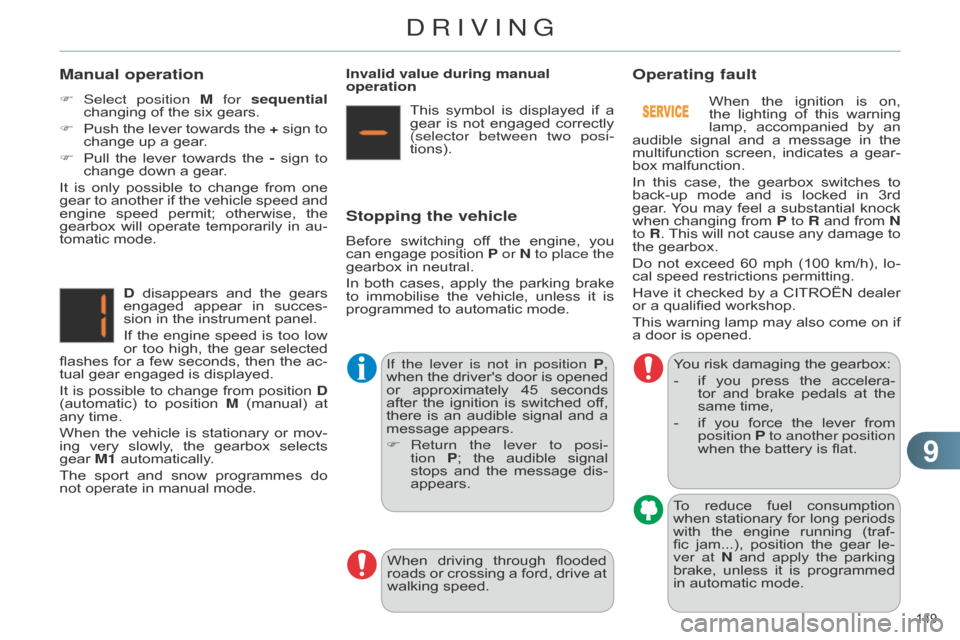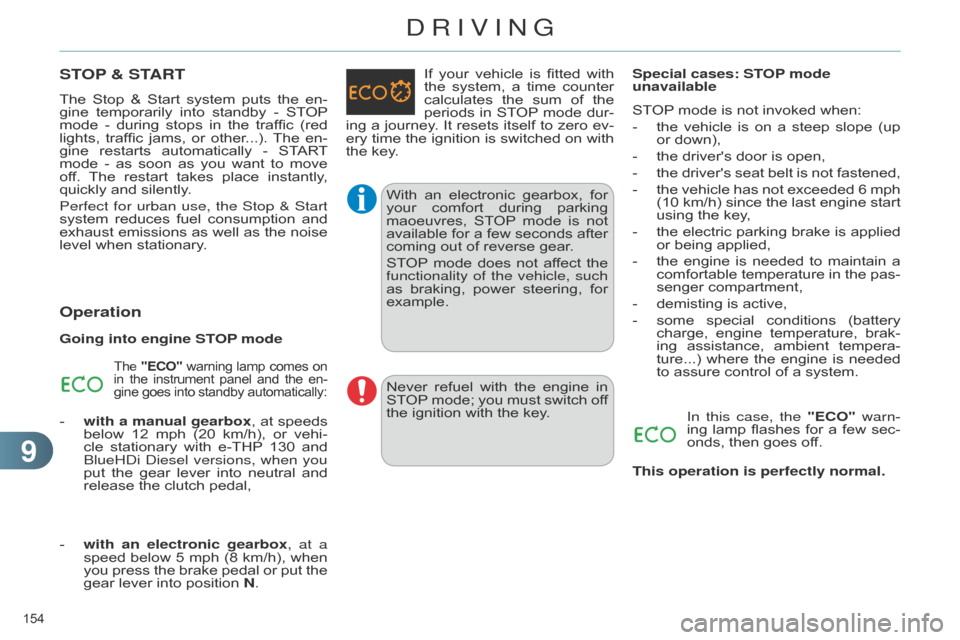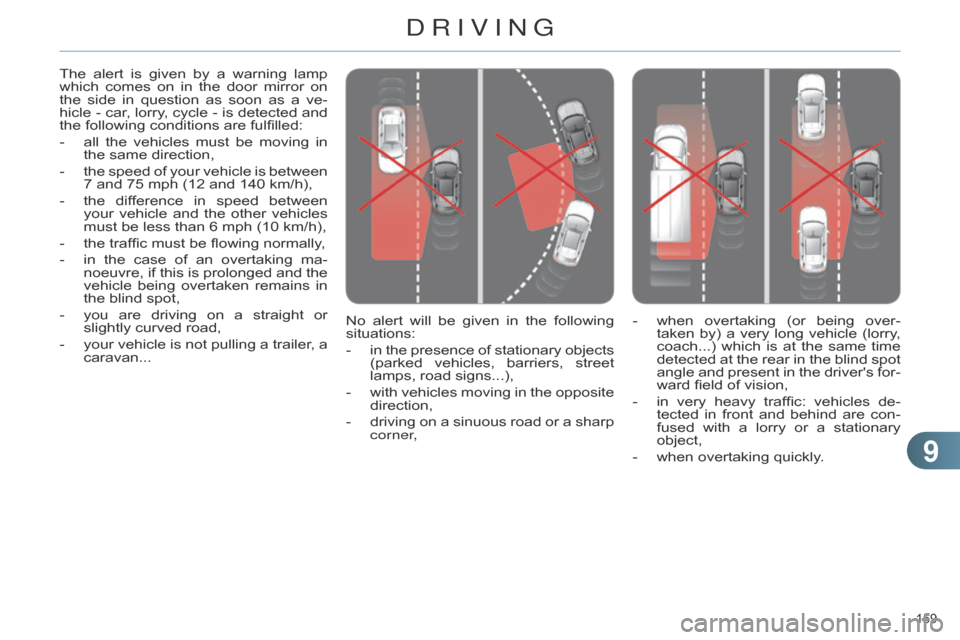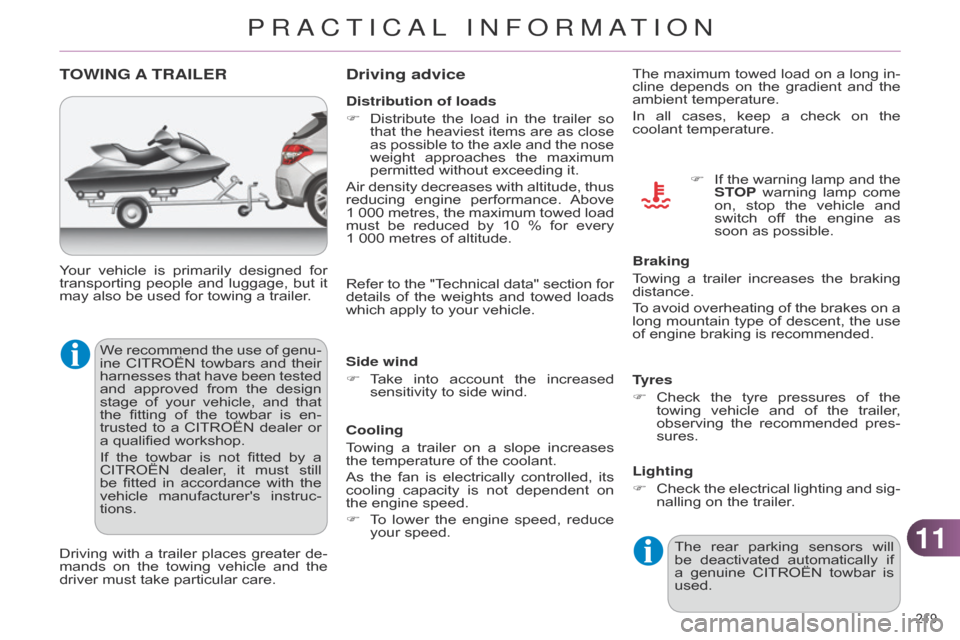warning light Citroen C4 DAG 2014.5 2.G User Guide
[x] Cancel search | Manufacturer: CITROEN, Model Year: 2014.5, Model line: C4 DAG, Model: Citroen C4 DAG 2014.5 2.GPages: 340, PDF Size: 12.89 MB
Page 130 of 340

88
128
C4-2_en_Chap08_securite_ed01-2014
The driver must ensure that passen -
gers use the seat belts correctly and
that
they
are
all
restrained
securely
before
setting off.
Wherever
you
are
seated
in
the
ve
-
hicle, always fasten your seat belt,
even
for short journeys.
Do
not
interchange
the
seat
belt
buckles
as
they
will
not
fulfil
their
role
fully
.
The
seat
belts
are
fitted
with
an
inertia
reel
permitting
automatic
adjustment
of
the
length
of
the
strap
to
your
size.
The
seat
belt
is
stowed
automatically
when
not in use.
Before
and
after
use,
ensure
that
the
seat
belt is reeled in correctly.
The
lower
part
of
the
strap
must
be
positioned
as
low
as
possible
on
the
pelvis.
The
upper
part
must
be
positioned
in
the
hollow of the shoulder.
The
inertia
reels
are
fitted
with
an
auto
-
matic
locking
device
which
comes
into operation in the event of a collision,
emergency
braking
or
if
the
vehicle rolls
over
.
Y
ou
can
release
the
device by
pulling
the
strap
firmly
and
then
re
-
leasing
it so that it reels in slightly.In
order to be ef fective, a seat belt must:
-
be
tightened
as
close
to
the
body
as possible,
-
be
pulled
in
front
of
you
with
a
smooth
movement,
checking
that
it
does not twist,
-
be
used
to
restrain
only
one
person,
-
not
bear
any
trace
of
cuts
or
fraying,
-
not
be
converted
or
modified
to
avoid
affecting its performance.
In
accordance
with
current
safety
regulations,
for
all
repairs
on
your
vehicle's
seat
belts,
go
to
a
qualified
workshop
with
the
skills
and
equip
-
ment
needed,
which
a
CITROËN
dealer
is able to provide.
Have
your
seat
belts
checked
regu
-
larly
by
a
CITROËN
dealer
or
a
qualified
workshop,
particularly
if
the
straps
show signs of damage.
Clean the seat belt straps with soapy
water
or
a
textile
cleaning
product,
sold
by CITROËN dealers.
After
folding
or
moving
a
seat
or
rear
bench seat, ensure that the seat belt
is
positioned and reeled in correctly.Recommendations for children
Use
a
suitable
child
seat
if
the
pas
-
senger
is
less
than
12
years
old
or
shorter
than one and a half metres.
Never
use
the
same
seat
belt
to
se
-
cure
more than one person.
Never
allow
a
child
to
travel
on
your
lap.
For
more
information,
refer
to
the
"Child
seats" section.
In the event of an impact
Depending on the nature and se-
riousness of the impact, the pre-
tensioning
device
may
be
deployed
before
and
independently
of
the
airbags.
Deployment
of
the
preten
-
sioners
is
accompanied
by
a
slight
discharge
of
harmless
smoke
and
a
noise,
due
to
the
activation
of
the
pyrotechnic
cartridge
incorporated
in
the
system.
In
all
cases,
the
airbag
warning
lamp
comes
on.
Following
an
impact,
have
the
seat
belts
system
checked,
and
if
neces
-
sary
replaced,
by
a
CITROËN
dealer
or
a qualified workshop.
SAFETY
Page 151 of 340

99
149
C4-2_en_Chap09_conduite_ed01-2014
Manual operation
F Select position M for sequential
changing of the six gears.
F
Push
the
lever
towards
the
+
sign
to
change
up a gear.
F
Pull
the
lever
towards
the
-
sign
to
change
down a gear.
It
is
only
possible
to
change
from
one
gear
to
another
if
the
vehicle
speed
and
engine
speed
permit;
otherwise,
the
gearbox
will
operate
temporarily
in
au
-
tomatic
mode.D
disappears
and
the
gears
engaged
appear
in
succes
-
sion
in the instrument panel.
If
the
engine
speed
is
too
low
or
too
high,
the
gear
selected
flashes
for
a
few
seconds,
then
the
ac
-
tual
gear engaged is displayed.
It
is
possible
to
change
from
position
D
(automatic)
to
position
M
(manual)
at
any
time.
When
the
vehicle
is
stationary
or
mov
-
ing
very
slowly
,
the
gearbox
selects
gear
M1 automatically.
The
sport
and
snow
programmes
do
not
operate in manual mode.Invalid value during manual
operation
This symbol is displayed if a
gear
is
not
engaged
correctly
(selector between two posi
-
tions).
Stopping the vehicle
Before switching of f the engine, you can
engage position P or N to place the
gearbox
in neutral.
In
both
cases,
apply
the
parking
brake
to
immobilise
the
vehicle,
unless
it
is
programmed
to automatic mode.
If the lever is not in position P,
when
the
driver's
door
is
opened
or
approximately
45
seconds
after
the
ignition
is
switched
of
f,
there
is
an
audible
signal
and
a
message
appears.
F
Return
the lever to posi-
tion
P
;
the
audible
signal
stops
and
the
message
dis
-
appears. You
risk damaging the gearbox:
-
if
you
press
the
accelera
-
tor
and
brake
pedals
at
the
same
time,
-
if
you
force
the
lever
from
position P
to another position
when
the battery is flat.
When
the
ignition
is
on,
the
lighting
of
this
warning
lamp,
accompanied
by
an
audible
signal
and
a
message
in
the
multifunction
screen,
indicates
a
gear
-
box malfunction.
In
this
case,
the
gearbox
switches
to
back-up
mode
and
is
locked
in
3rd
gear
.
Y
ou
may
feel
a
substantial
knock
when
changing
from
P
to R
and
from
N
to R. This will not cause any damage to the
gearbox.
Do
not
exceed
60
mph
(100
km/h),
lo
-
cal
speed restrictions permitting.
Have
it
checked
by
a
CITROËN
dealer
or
a qualified workshop.
This
warning
lamp
may
also
come
on
if
a
door is opened.
Operating fault
To reduce fuel consumption when
stationary for long periods
with
the
engine
running
(traf
-
fic
jam...),
position
the
gear
le
-
ver at
N
and
apply
the
parking
brake,
unless
it
is
programmed
in
automatic mode.
When
driving
through
flooded
roads
or
crossing
a
ford,
drive
at
walking
speed.
DRIVING
Page 156 of 340

99
154
C4-2_en_Chap09_conduite_ed01-2014
STOP & START
The Stop & Start system puts the en -
gine temporarily into standby - ST OP mode
-
during
stops
in
the
traffic
(red
lights,
traffic
jams,
or
other
...).
The
en
-
gine
restarts
automatically
-
ST
ART
mode
-
as
soon
as
you
want
to
move
of
f.
The
restart
takes
place
instantly
,
quickly
and silently.
Perfect for urban use, the Stop & Start
system
reduces
fuel
consumption
and
exhaust
emissions
as
well
as
the
noise
level
when stationary.
Operation
Going into engine STOP mode
The "ECO" warning lamp comes on in
the instrument panel and the en -
gine
goes into standby automatically:
- with a manual gearbox, at speeds below
12 mph (20 km/h), or vehi -
cle
stationary
with
e-THP 130
and
b
lueH d i
d
iesel versions, when you
put
the
gear
lever
into
neutral
and
release
the clutch pedal, If
your
vehicle
is
fitted
with
the
system,
a
time
counter
calculates
the
sum
of
the
periods
in
ST
OP
mode
dur
-
ing
a
journey
.
It
resets
itself
to
zero
ev
-
ery
time
the
ignition
is
switched
on
with
the
key.
-
with
an electronic gearbox, at a
speed
below
5
mph
(8
km/h),
when
you
press
the
brake
pedal
or
put
the
gear
lever into position N.With
an
electronic
gearbox,
for
your
comfort
during
parking
maoeuvres,
ST
OP
mode
is
not
available
for
a
few
seconds
after
coming
out of reverse gear.
STOP
mode
does
not
af
fect
the
functionality of the vehicle, such
as
braking,
power
steering,
for
example.Special cases: ST
OP mode
unavailable
STOP
mode is not invoked when:
-
the
vehicle
is
on
a
steep
slope
(up
or
down),
-
the
driver's door is open,
-
the
driver's
seat
belt
is
not
fastened,
-
the
vehicle
has
not
exceeded
6
mph
(10
km/h)
since
the
last
engine
start
using
the key,
-
the
electric
parking
brake
is
applied
or
being applied,
-
the
engine
is
needed
to
maintain
a
comfortable
temperature
in
the
pas
-
senger compartment,
-
demisting
is active,
-
some
special
conditions
(battery
charge,
engine
temperature,
brak
-
ing
assistance,
ambient
tempera
-
ture...)
where
the
engine
is
needed
to
assure control of a system.
In this case, the "ECO" warn-
ing lamp flashes for a few sec -
onds,
then goes off.
Never
refuel
with
the
engine
in
ST
OP
mode;
you
must
switch
of
f the
ignition with the key.
This operation is perfectly normal.
DRIVING
Page 161 of 340

99
159
C4-2_en_Chap09_conduite_ed01-2014
No alert will be given in the following situations:
-
in
the
presence
of
stationary
objects
(parked
vehicles,
barriers,
street
lamps,
road signs...),
-
with
vehicles
moving
in
the
opposite
direction,
-
driving
on
a
sinuous
road
or
a
sharp
corner
,
The
alert
is
given
by
a
warning
lamp
which
comes
on
in
the
door
mirror
on
the
side
in
question
as
soon
as
a
ve
-
hicle
-
car
,
lorry
,
cycle
-
is
detected
and
the
following
conditions
are
fulfilled:
-
all
the
vehicles
must
be
moving
in
the
same
direction,
-
the
speed
of
your
vehicle
is
between
7
and
75
mph
(12
and
140
km/h),
-
the
dif
ference
in
speed
between
your
vehicle
and
the
other
vehicles
must
be
less
than
6
mph
(10
km/h),
-
the
traffic
must
be
flowing
normally,
-
in
the
case
of
an
overtaking
ma
-
noeuvre,
if
this
is
prolonged
and
the
vehicle
being
overtaken
remains
in
the
blind
spot,
-
you
are
driving
on
a
straight
or
slightly
curved
road,
-
your
vehicle
is
not
pullin
g
a
trailer
,
a
caravan... -
when overtaking (or being over -
taken by) a very long vehicle (lorry ,
coach...)
which
is
at
the
same
time
detected
at
the
rear
in
the
blind
spot
angle
and
present
in
the
driver's
for
-
ward
field of vision,
-
in
very
heavy
traffic:
vehicles
de
-
tected
in
front
and
behind
are
con
-
fused
with
a
lorry
or
a
stationary
object,
-
when
overtaking quickly.
DRIVING
Page 221 of 340

1111
219
C4-2_en_Chap11_info-pratique_ed01-2014
TOWING A TRAILER
We recommend the use of genu -
ine CITROËN towbars and their
harnesses
that
have
been
tested
and
approved
from
the
design
stage
of
your
vehicle,
and
that
the
fitting
of
the
towbar
is
en
-
trusted
to
a
CITROËN
dealer
or
a
qualified workshop.
If
the
towbar
is
not
fitted
by
a
CITROËN
dealer
,
it
must
still
be
fitted
in
accordance
with
the
vehicle
manufacturer's
instruc
-
tions.
Your
vehicle
is
primarily
designed
for
transporting
people
and
luggage,
but
it
may
also be used for towing a trailer.
Driving
with
a
trailer
places
greater
de
-
mands
on
the
towing
vehicle
and
the
driver
must take particular care.
Driving advice
Distribution of loads
F
Distribute
the
load
in
the
trailer
so
that
the
heaviest
items
are
as
close
as
possible
to
the
axle
and
the
nose
weight
approaches
the
maximum
permitted
without exceeding it.
Air
density
decreases
with
altitude,
thus
reducing
engine
performance.
Above
1
000
metres,
the
maximum
towed
load
must
be
reduced
by
10
%
for
every
1 000
metres of altitude.
Side wind
F
T
ake
into
account
the
increased
sensitivity
to side wind.
Cooling
Towing
a
trailer
on
a
slope
increases
the
temperature of the coolant.
As
the
fan
is
electrically
controlled,
its
cooling
capacity
is
not
dependent
on
the
engine speed.
F
T
o
lower
the
engine
speed,
reduce
your
speed. The
maximum
towed
load
on
a
long
in
-
cline depends on the gradient and the ambient
temperature.
In all cases, keep a check on the
coolant
temperature.
F
If
the
warning
lamp
and
the
ST
OP
warning
lamp
come
on,
stop
the
vehicle
and
switch
of
f
the
engine
as
soon
as possible.
Braking
Towing
a
trailer
increases
the
braking
distance.
T
o
avoid
overheating
of
the
brakes
on
a
long
mountain
type
of
descent,
the
use
of
engine braking is recommended.
Tyres
F
Check
the
tyre
pressures
of
the
towing
vehicle
and
of
the
trailer
,
observing
the
recommended
pres
-
sures.
Lighting
F
Check
the
electrical
lighting
and
sig
-
nalling
on the trailer.
Refer
to
the
"T
echnical
data"
section
for
details
of
the
weights
and
towed
loads
which
apply to your vehicle.
The
rear
parking
sensors
will
be
deactivated
automatically
if
a
genuine
CITROËN
towbar
is
used.
PRACTICAL INFORMATION
Page 227 of 340

225
C4-2_en_Chap12_caracteristique_ed01-2014
* The kerb weight is equal to the unladen weight + driver (75 kg).
**
The
weight
of
the
braked
trailer
can
be
increased,
within
the
GTW
limit,
if
the
GVW
of
the
towing
vehicle
is
reduced
by
an
equal amount. Warning: towing using a lightly loaded towing vehicle may have an adverse effect on its road holding.
PETROL WEIGHTS AND TOWED LOADS ( IN KG )
The GTW and towed load values indicated are valid up to a maximum altitude of 1 000 metres; the towed load mentioned must
be reduced by 10 % for each additional 1 000 metres of altitude.
When
towing, the maximum authorised speed is reduced (comply with the legislation in force in your country).
High
ambient
temperatures
may
result
in
a
reduction
in
the
performance
of
the
vehicle
to
protect
the
engine;
if
the
ambient
temperature
is above 37 °C, limit the towed load.
Petrol engine
VTi 95 THP 110VTi 120
Gearbox Manual Manual Manual Automatic
Model code:
NC... 8FR0HNZ6
HNZ6/1 -/2 5FS05FS9
5FS9/D
-
Unladen
weight
1 200
1 200
1 205
1 270
-
Kerb
weight*
1 275
1 275
1 280
1 345
-
Gross
vehicle weight (GVW)
1 720
1 770
1 765
1 755
-
Gross
train weight (GTW)
on
a 12 % gradient
2 920
2 970
3 065
3 055
-
Braked
trailer (within the GTW limit)
on
a 12 % gradient
1 200
1 200
1 300
1 300
-
Braked
trailer**
(with
load
transfer
within
the
GTW
limit)
1 450
1 450
1 550
1 550
-
Unbraked
trailer
635635640670
-
Recommended
nose weight
75757575
12
TECHNICAL DATA
Page 228 of 340

226
C4-2_en_Chap12_caracteristique_ed01-2014
* The kerb weight is equal to the unladen weight + driver (75 kg).
**
The
weight
of
the
braked
trailer
can
be
increased,
within
the
GTW
limit,
if
the
GVW
of
the
towing
vehicle
is
reduced
by
an
equal amount. Warning: towing using a lightly loaded towing vehicle may have an adverse effect on its road holding.
The
GTW
and
towed
load
values
indicated
are
valid
up
to
a
maximum
altitude
of
1
000
metres;
the
towed
load
mentioned
must
be reduced by 10 % for each additional 1 000 metres of altitude.
When
towing, the maximum authorised speed is reduced (comply with the legislation in force in your country).
High
ambient
temperatures
may
result
in
a
reduction
in
the
performance
of
the
vehicle
to
protect
the
engine;
if
the
ambient
temperature
is above 37 °C, limit the towed load.
Petrol engine
e-THP 130THP 155
Gearbox ManualElectronic
Model code:
NC... HNYM/S
HNYM/1S 5FV8/P
-
Unladen
weight
1 205
1 275
-
Kerb
weight*
1 280
1 350
-
Gross
vehicle weight (GVW)
1 790
1 805
-
Gross
train weight (GTW)
on
a 12% gradient
3 090
3 205
-
Braked
trailer (within the GTW limit)
on
a 12% gradient
1 300
1 400
-
Braked
trailer** (with load transfer within the
GTW
limit)
1 550
1 650
-
Unbraked
trailer
640675
-
Recommended
nose weight
7575
12
TECHNICAL DATA
Page 231 of 340

229
C4-2_en_Chap12_caracteristique_ed01-2014
* The kerb weight is equal to the unladen weight + driver (75 kg).
**
The
weight
of
the
braked
trailer
can
be
increased,
within
the
GTW
limit,
if
the
GVW
of
the
towing
vehicle
is
reduced
by
an
equal amount. Warning: towing using a lightly loaded towing vehicle may have an adverse effect on its road holding.
DIESEL WEIGHTS AND TOWED LOADS ( IN KG )
The GTW and towed load values indicated are valid up to a maximum altitude of 1 000 metres; the towed load mentioned must
be reduced by 10 % for each additional 1 000 metres of altitude.
When
towing, the maximum authorised speed is reduced (comply with the legislation in force in your country).
High
ambient
temperatures
may
result
in
a
reduction
in
the
performance
of
the
vehicle
to
protect
the
engine;
if
the
ambient
temperature
is above 37 °C, limit the towed load.
Diesel engine
HDi 90 HDi 90 FAP BlueHDi 100 e-HDi 115
Gearbox Manual ManualManualManual
Model code:
NC... 9H j C
9H j C/1
9HP0 BHY6
BHY6/1 BHY6/2S 9HD8/S
9HD8/1S 9HD8/2S
-
Unladen
weight
1 248 1 205 1 200 1 205 1 280 1 280
-
Kerb
weight*
1 323 1 280 1 275 1 280 1 355 1 355
-
Gross
vehicle weight (GVW) 1 745 1 790 1 830 1 840 1 820 1 820
-
Gross
train weight (GTW)
on
a 12 % gradient
2 545 2 890 3 130 3 140 3 120 2 220
-
Braked
trailer (within GTW limit)
on
12 % gradient
800 1 100 1 300 1 300 1 300 400
-
Braked
trailer**
(with
load
transfer
with
the GTW limit)
1 050 1 350 1 550 1 550 1 550 600
-
Unbraked
trailer
640 640 635 640 670 400
-
Recommended
nose weight
757575757575
12
TECHnICaL daTa
Page 232 of 340

230
C4-2_en_Chap12_caracteristique_ed01-2014
* The kerb weight is equal to the unladen weight + driver (75 kg).
**
The
weight
of
the
braked
trailer
can
be
increased,
within
the
GTW
limit,
if
the
GVW
of
the
towing
vehicle
is
reduced
by
an
equal amount. Warning: towing using a lightly loaded towing vehicle may have an adverse effect on its road holding.
The
GTW
and
towed
load
values
indicated
are
valid
up
to
a
maximum
altitude
of
1
000
metres;
the
towed
load
mentioned
must
be reduced by 10 % for each additional 1 000 metres of altitude.
When
towing, the maximum authorised speed is reduced (comply with the legislation in force in your country).
High
ambient
temperatures
may
result
in
a
reduction
in
the
performance
of
the
vehicle
to
protect
the
engine;
if
the
ambient
temperature
is above 37 °C, limit the towed load.
Diesel engine
e-HDi 115BlueHDi 115 BlueHDi 120 HDi 150 FAP
Gearbox ElectronicManual Manual Manual
Model code:
NC... 9HD8/1PS 9HD8/2PSBHXM/S
BHXM/1S -/2S BHZM/S
BHZM/1S -/2S RHE8
RHE8/1
-
Unladen
weight
1 205 1 205 1 280 1 280 1 320
-
Kerb
weight*
1 280 1 280 1 355 1 355 1 395
-
Gross
vehicle weight (GVW)
1 825 1 825 1 860 1 860 1 885
-
Gross
train weight (GTW)
on
12 % gradient
3 125 2 225 3 160 3 160 3 385
-
Braked
trailer (within GTW limit)
on
12 % gradient
1 300
4001 300 1 300 1 500
-
Braked
trailer**
(with
load
transfer
with
the GTW limit)
1 550
6001 550 1 550 1 750
-
Unbraked
trailer
635400675675695
-
Recommended
nose weight
7575757575
12
TECHNICAL DATA
Page 330 of 340

328
C4-2_en_Chap14_index-alpha_ed01-2014
Courtesy mirror ............................ 96
Cruise control .................... 161, 164
Cup
holder
................................... 98
DAB
(Digital
Audio
Broadcasting)
................ 272,
273,
300,
301
Date
(setting)
................... 35,
37, 42
Daytime
running
lamps
........................ 82,
202, 204
Deactivating
the passenger
airbag...................................... 129
Defrosting
.................................... 56
Diesel
additive level
................... 180
Diesel
engine pre-heat
warning
lamp
............................ 26
Dimensions
................................ 232
Dipped
beam
............... 81,
202, 204
Dipstick
................................ 29,
178
Directional
lighting
................. 88,
89
Direction
indicators
............. 84,
122,
202,
203, 206
d
oors
........................................... 76
Doors
emergency
control
....................................... 73d
oor trays
.................................... 95
Driving
positions
(memorising)
............................. 61
Dynamic
emergency
braking
.................................... 137
Dynamic
stability control
(
d SC)
...................................... 124 Eco-driving
.................................. 10
Eco-driving (advice) ..................... 10
Economical
driving
..................... 10
Economy
mode.......................... 215
Electric
window controls
.............. 78
Electronic
brake force
distribution
(EBFD)
................. 123
Electronic
engine
immobiliser
....................... 71,
134
Electronic
gearbox
system
...... 10,
144, 154, 182, 214
Emergency
boot release.............. 77
Emergency
braking system
....... 123
Emergency
call
.......... 125,
235, 236
Emergency
warning lamps
........ 122
Emissions
control system,
SCR
.......................................... 24
eMyW
ay
............................... 41,
237
Energy
economy mode.............. 215
Engine
compartment
......... 176,
177
Engine
compartment
fusebox
................................... 208
Engine,
Diesel
.................... 26,
172,
174,
177, 227
Engine
oil
................................... 178
Engine
oil level indicator
...... 29,
178
Engine,
petrol
............ 172,
176, 223
Engines.............................. 223,
227
Environment
.......................... 10,
71
Equipment
settings
.... 35,
37, 41, 42Flashing
indicators.............. 84, 122,
203, 205
Foglamps,
rear
.................... 83,
206
Front
foglamps....... 83, 89, 202, 205
Front seats ....................... 57,
58, 61
Fuel...................................... 10,
172
Fuel
consumption
........................ 10
Fuel
filler flap
..................... 171,
173
Fuel
gauge................................. 171
Fuel
tank
............................ 171,
173
Fusebox,
dashboard
.................. 208
Fuses
......................................... 208
D
Fillin
g with fuel
.................... 171-173
Fitting
a wheel
........................... 198
Fitting
roof bars.......................... 216
Fittings,
boot
...................... 104,
107
Fitting
speakers
......................... 220
F G
Gearbox,
automatic
............ 10,
147,
182,
214
Gearbox,
manual
.............. 10,
143, 154, 182
Gear
efficiency indicator
............ 151
Gear lever
.................................... 10
Gear
lever, automatic
gearbox................................... 147
Gear
lever, manual gearbox
...... 143
Glove
box
.................................... 96
G.P
.S.
........................................ 246
Grab
handles
............................... 95
Guidance
........................... 244,
251
EBA
(Emergency braking
assistance)
............................. 123
E H
Halogen
headlamps................... 202
Hands-free
kit
.................... 260,
309
Hazard
warning lamps
............... 122
Headlamp
adjustment.................. 87
Headlamps,
directional
.....87,
88, 202
Headlamp
wash
........................... 91
aLPHabETICaL IndEx